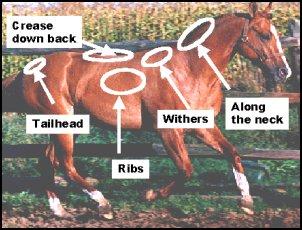Body Conditioning Scoring:
A useful skill for horse owners
by Gayle Ecker, B.A., B.Ed. M.Sc., Leslie Huber
D.V.M. and
Wendy Driscoll, R.A.E.
Equine Research Centre, Guelph, Ontario
Body condition scoring is a
hands-on, subjective method for evaluating a horse's condition or fat cover.
During colder months, this method will keep you aware of minor weight changes
before your horse reaches a serious (2-3) condition. Perfect for use in
climates where winter hair and blankets may hide the "real" horse.
Temperature extremes over extended time periods, may change feed requirements
to maintain a horse's condition. Lost condition may result in increased
training time and feed costs. It is usually easier to get extra weight off than
try to put weight on. An increase of 1 condition score requires 16 - 20 kg of
weight gain. For a 500 kg horse, a change in score from 4 to 5 will need a
daily increase of 5.3-6.7 Mcal/day above maintenance or about 1.5 flakes of hay
more, per day. At this rate, it will take 60 days to put the weight on! Ask
your friends to participate and evaluate monthly!

Body Scores
and Appearances
1. Extremely thin.
The horse is extremely emaciated. The backbone, ribs, hipbones and tailhead are
all prominent. The neck is hollow, and the bones of the shoulders, withers and
neck are easily discerned. Individual vertebrae are clearly seen and easily
palpated. No fat can be palpated.
2. Very thin.
The back bone is prominent, ribs, tailhead, and pelvic bone stand out. Bone
structures of the neck, withers, and shoulder are evident. Individual vertebrae
can be seen and easily palpated. Animal is emaciated.
3. Thin.
The backbone is prominent . A slight fat layer can be felt over the ribs, the
tailhead is evident, but individual vertebrae cannot be seen. The hip bones
cannot be seen, but withers, shoulder and neck are emphasized.
4. Moderately Thin.
A negative crease along its back. An outline of the ribs can be seen. Fat is
palpable around the tailhead. Hip bones bones cannot be seen. Withers, neck and
shoulders are not obviously thin.
5. Moderate.
Back is level. Ribs can be felt but not easily seen. Fat around tailhead feels
spongy. Withers are rounded and shoulders and neck blend smoothly into the
body.
6. Moderately Fleshy.
A slight crease is along the back. Fat on the tailhead feels soft. Fat over the
ribs is spongy. Small deposits of fat along the withers, behind the shoulders
and along the neck.
7. Fleshy.
A crease is seen down the back. Ribs may be felt but fat between ribs is
obvious. Fat on tailhead is soft. Noticeable fat along neck, behind shoulders
and withers.
8. Fat.
Crease down back is prominent. Ribs difficult to feel due to fat in between.
Wither area is filled with fat, and very soft fat over tailhead. The space
behind shoulders is filled in and flush, and there is fat along the inner
buttocks.
9. Extremely Fat.
The crease down the back is very prominent. Fat is in patches over rib area,
with bulging fat over tailhead, withers, neck and shoulders. Fat along inner
buttocks may rub together and flank is filled in flush.
Adapted from Henneke et al (1983) Equine Veterinary Journal 15: 371-372
Suggested Condition Scores
for Different Disciplines
| Endurance |
|
4-5 |
| Eventing |
|
4-5 |
| Polo |
|
4-5 |
| Ranch |
|
4-5 |
| Open mare |
|
4-6 |
| Stallion (off season) |
|
4-6 |
| Standardbred
racehorse |
|
4-6 |
| Thoroughbred
racehorse |
|
5-7 |
| Hunter |
|
5-7 |
| Showjumper |
|
5-7 |
| Breeding stallion |
|
5-7 |
| Dressage |
|
6-8 |
| Quarter horse |
|
6-8 |
| Show hack |
|
6-8 |
| Pony |
|
7-8 |
| Pregnant mare |
|
7-8 |
Adapted from Feeding and Nutrition, The Making of a Champion by John
Kohnke, 1992, page 165, Birubi Pacific.
|

